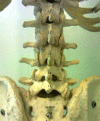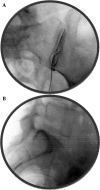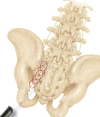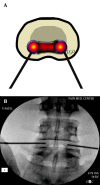Interventional Therapies for Chronic Low Back Pain: A Focused Review (Efficacy and Outcomes)
- PMID: 26484298
- PMCID: PMC4604560
- DOI: 10.5812/aapm.29716
Interventional Therapies for Chronic Low Back Pain: A Focused Review (Efficacy and Outcomes)
Abstract
Context: Lower back pain is considered to be one of the most common complaints that brings a patient to a pain specialist. Several modalities in interventional pain management are known to be helpful to a patient with chronic low back pain. Proper diagnosis is required for appropriate intervention to provide optimal benefits. From simple trigger point injections for muscular pain to a highly complex intervention such as a spinal cord stimulator are very effective if chosen properly. The aim of this article is to provide the reader with a comprehensive reading for treatment of lower back pain using interventional modalities.
Evidence acquisition: Extensive search for published literature was carried out online using PubMed, Cochrane database and Embase for the material used in this manuscript. This article describes the most common modalities available to an interventional pain physician along with the most relevant current and past references for the treatment of lower back pain. All the graphics and images were prepared by and belong to the author.
Results: This review article describes the most common modalities available to an interventional pain physician along with the most relevant current and past references for the treatment of lower back pain. All the graphics and images belong to the author. Although it is beyond the scope of this review article to include a very detailed description of each procedure along with complete references, a sincere attempt has been made to comprehensively cover this very complex and perplexing topic.
Conclusion: Lower back pain is a major healthcare issue and this review article will help educate the pain practitioners about the current evidence based treatment options.
Keywords: Decompression; Discography; Facet Joint; Interventional Therapies; Intradiscal Procedures, Disc; Low Back Pain; Procedures; Sacroiliac joint; Spinal Cord Stimulation.
Figures
























References
-
- Manchikanti L, Cash KA, Pampati V, McManus CD, Damron KS. Evaluation of fluoroscopically guided caudal epidural injections. Pain Physician. 2004;7(1):81–92. - PubMed
-
- Hansen HC. Is fluoroscopy necessary for sacroiliac joint injections? Pain Physician. 2003;6(2):155–8. - PubMed
-
- Jasper JF. Role of digital subtraction fluoroscopic imaging in detecting intravascular injections. Pain Physician. 2003;6(3):369–72. - PubMed
Publication types
LinkOut - more resources
Full Text Sources
Other Literature Sources
Medical
Miscellaneous
